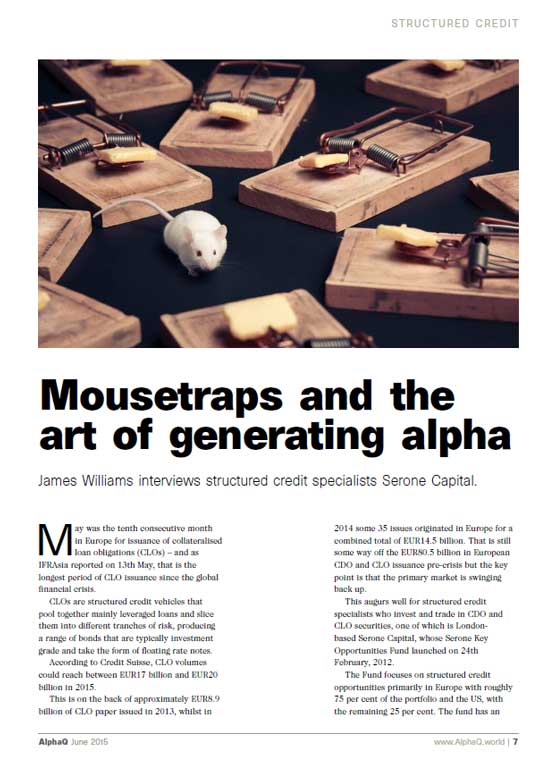Mousetraps and the Art of Generating Alpha
James Williams interviews structured credit specialists Serone Capital.

May was the tenth consecutive month in Europe for issuance of collateralised loan obligations (CLOs) – and as IFRAsia reported on 13th May, that is the longest period of CLO issuance since the global financial crisis.
CLOs are structured credit vehicles that pool together mainly leveraged loans and slice them into different tranches of risk, producing a range of bonds that are typically investment grade and take the form of floating rate notes.
According to Credit Suisse, CLO volumes could reach between EUR17 billion and EUR20 billion in 2015.
This is on the back of approximately EUR8.9 billion of CLO paper issued in 2013, whilst in 2014 some 35 issues originated in Europe for a combined total of EUR14.5 billion. That is still some way off the EUR80.5 billion in European CDO and CLO issuance pre-crisis but the key point is that the primary market is swinging back up.
This augurs well for structured credit specialists who invest and trade in CDO and CLO securities, one of which is Londonbased Serone Capital, whose Serone Key Opportunities Fund launched on 24th February, 2012.
The Fund focuses on structured credit opportunities primarily in Europe with roughly 75 per cent of the portfolio and the US, with the remaining 25 per cent. The fund has an annualised target return of 12 per cent.
“Everything we buy is a CUSIP/ISIN bond secured on a portfolio of assets. We invest in corporate, consumer, and real estate risk but always via a structured credit securities.
“In terms of the opportunity set, we like to trade across the capital structure. We look at senior, mezzanine and equity tranches. We believe in trying to diversify as much as we possibly can. We do this by looking at different types of deals, managers, vintages, screening for overlap and aiming to minimise idiosyncratic default risk. We are big believers in trying to diversify away as much risk as we can,” explains CEO Neil Servis.
In structured credit transactions, the senior tranche typically comprises triple-A rated bonds offering the lowest risk to default and consequently the lowest yield. Mezzanine paper is also investment grade rated but has a higher risk and yield profile, while the equity (first loss) tranche typically has no credit rating but offers the highest risk/return profile; yields are often north of 10 per cent.

“We believe that structured credit is an investment strategy that can stand the test of time. For example, if you look at triple-A paper in the CLO new issue market the securities trade at 135 to 140 basis points over Euribor. Add to that the fact that it is floating rate paper and very default-remote and one begins to understand the attraction of this market,” says Servis.
To illustrate the point, Penta Capital, a CLO manager, issued the Penta CLO 2 backed by EUR414.1 million of leveraged loans on 6th May. The CLO is triple-A rated and priced at 135 basis points over Euribor.
Parts of the structured credit market gained a poor reputation postcrisis primarily on the back of paper secured on portfolios of US sub-prime mortgages. Away from the sub-prime sector other parts of the market held up well. Between 1994 and 2013, US CLOs rated AAA had a zero per cent default rate. A-rated CLOs only had a 0.45 per cent default rate, according to Standard & Poor’s, and if one were to look across all CLO tranches – AAA to B – the average default rate was just 0.41 per cent.
This is a point not wasted at Serone, who blend both 1.0 CLOs dating as far back as 2005 and post-crisis issues. These instruments often gain stability to as they approach maturity.
“Relative to many parts of the financial markets, European CLOs actually performed well throughout the crisis. One could argue that they did exactly what they said on the tin and furthermore legal infrastructure of the transactions, when tested, held up well. Broadly, all paper that was rated BBB or above paid back the principal plus par,” says Servis, who continues:
“There are still some constraints for investors. Structured credit securities arguably carry a high cost to regulatory capital within Basel III and Solvency II but for us we see that as an opportunity. Furthermore difficulty in accessing bonds and the need for advanced analytical capabilities have created further barriers to entry.”
It’s fair to say that the investment opportunity in Europe’s CLO/CDO market still lags behind the US by several years. One point of differentiation, which is helping managers like Serone Capital to source alpha, is that unlike the US, Europe still has a lot of legacy CLO 1.0s outstanding.
“These are pre-crisis CLOs that are still trading at a discount, and so are pulling to par. Further complexity, non-uniformity provide significant event-driven returns and we find these securities a very good place to generate alpha,” says Hassan Jeraj, who heads up investor relations at Serone Capital.
Serone Capital’s strategy is not one of ‘buy and hold’. Although it might sound obvious to say that the team will trade out of a position today if they think it will be worth less tomorrow, there are plenty of structured credit managers who will sit tight and hold for the longer term.
“We don’t do that; we’re constantly looking to extract value by trading and thinking about the exit so if that means dropping a losing trade we’ll do so,” says Servis.
As a result, the trading strategy is such that Servis and his team have to be confident that the bonds they buy can be traded in and out of efficiently, which obviously means that liquidity management is a key tool in the overall risk management exercise.
Here again, Europe is showing signs of improvement. The market is a lot more liquid than it was a few years ago in part thanks to the ECB’s commitment to quantitative easing. But as Servis rightly points out, the issue with liquidity is that it can always disappear.
“That’s what we are always very conscious of, from a risk management perspective. The assets we buy, we are comfortable holding for the long term but that’s not necessarily our best outcome. We actively manage the portfolio. Typically we hold positions on average for approximately a year. However, we may exit out much sooner if the risk profile changes,” confirms Servis.
Investors are rightly concerned about the impact that a raising interest rate environment will have on their global fixed income portfolios. They are actively looking for alternative strategies to hedge against this scenario.
The fact that CLOs not only offer attractive yields but are also floating rate notes secured primarily on floating rate assets makes them particularly appealing to institutional investors.
Not that rates are expected to rise anytime soon in Europe.
Indeed, Jeraj notes that in terms of European loan issuance, more US corporate issuers are coming to Europe precisely because of the low rate environment. This is helping structured credit managers like Serone Capital from a diversification perspective as it allows them to build exposure to different corporates and spread risk in the portfolio.
Servis says that transparency is key when Serone makes an investment. “We need to be able to clearly analyse the underlying CDO or CLO portfolio from the bottom up to price this risk. In terms of European geographies, we are looking more at core Europe than the periphery. We want to try and find high quality corporate credit opportunities.
“We aren’t particularly sector focused. When you look at CLOs, you have got to, by default, be heavily diversified. One interesting sector to refer to, though, is the US energy market. There’s been a big sell-off and follow on volatility in energy and as a result that has fed into energy-focused CLOs, which has created a number of interesting opportunities.
“We are always thinking about the downside in any investments we make. We have some exposure to US energy but it’s limited and well defined,” confirms Servis.
Defaults are the major risk to any structured credit portfolio. Jeraj says that the metaphor they share with investors is to imagine stepping in to a room full of mousetraps. The art of successfully investing in structured credit is to ensure that if you do step on one mousetrap it doesn’t set all the others off in the room.
“We want to isolate the potential for defaults as much as possible in the companies we select, and try to ensure they are uncorrelated to each other. The strategy is built in such a way as to expect defaults.
“We’ve got thousands of credit positions in the portfolio and the market broadly prices on an expected two per cent default rate as a base case,” explains Jeraj. “We model all sorts of different scenarios and stress tests under different default profiles such as a uniform increase (in defaults) over a long period of time or sharp spikes, with various recovery rates.
As one can imagine, monitoring the credit situation in thousands of companies is a tall order but a fundamentally important one. Servis says that if the team sees collateral price falls (in the loans and bonds contained in the CLO market) it is possible to model the impact into the CLO, as well as other likely and extreme outcomes.
“While we are running thousands of names we can easily identify hot spots of potential trouble within our systems and see how that might impact the portfolio.”
“At the end of the day we are a credit manager and we are constantly thinking about how to protect the downside and generate consistent, stable returns for our investors. Since the fund’s inception over three years ago it has only incurred a marginal drawdown on two occasions; one month it was down 0.03 per cent, another month it was down 0.06 per cent,” confirms Servis. The 40 month track record has recorded annualised returns in excess of 30 per cent, with the LTM performance of 14 per cent (to April 15).
Part of the fund’s alpha generation comes from exploiting convexity in tranches that are trading at an attractive discount i.e. 80 or 90 cents on the dollar. Serone’s credit analysts then work from the bottom up to decide whether it is a good investment. If yes and the bond has potential to pull back to par over time it gets added to the portfolio.
As mentioned above, the CLO market is inefficient, which has allowed Serone to build a portfolio that includes multiple return drivers that are alpha driven. “Optionality is poorly priced by the market, giving rise to interesting trades with respect to control rights, pricing of non-cash flowing pieces and refinancing of the entire CLO structure. Execution of trades also presents opportunities for generating excess returns. If, as expected, the primary market for CLO issuance in Europe continues to build momentum, there should be good long-term opportunities for institutions looking to hedge their fixed income portfolios.”
Published
24 June 2015


